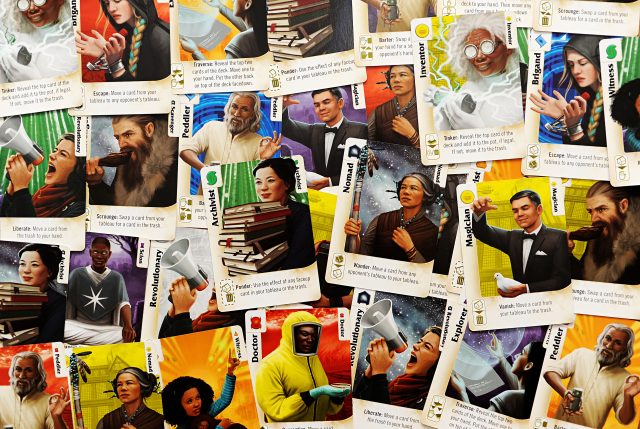When people think “trick-taking game” they generally get nostalgic for endless games late at night in the Common Room, or at the cottage. And if you grew up with one or more of these games, you’re used to the idea that there is a trump suit which is either pre-designated (as in Hearts or Spades) or set by the first or highest bidder (as in Euchre or Bridge).
Actually, designers have been messing with this assumption for ages, at least as far back as the splendid Mü (1995). In that game there are two trumps, with the highest bidder getting to declare the “higher” one and the second-highest setting the “lower” one. (Plus, in Mü trump can be either a suit or a number, which means you end up with situations where the yellow 7’s–there are 2 of them, by the way–can trump anything else…yeah, it’s a strange and wonderful game.)
Anyhoo, now Daniel Solis, designer of such fine games as Kodama and The Princess Bride: As You Wish has put his own twist on trick-taking with TRICKSTER: Champions of Time. Up to seven players take the role of (you guessed it) tricksters who are trying to get each other in the most poo-poo while staying out of trouble themselves.
 The game is played with a 56-card deck of seven Heroes in eight different suits (well-demarcated to assist the colour-blind). Since the game comes with 14 Heroes, there are (getting out my trusting calculator) 3,432 possible setups–not as many as Dominion, okay, but still plenty. In my first play we used the Beginner Deck suggested in the rules; there is also a Strategist Deck provided, as well as rules for drafting.
The game is played with a 56-card deck of seven Heroes in eight different suits (well-demarcated to assist the colour-blind). Since the game comes with 14 Heroes, there are (getting out my trusting calculator) 3,432 possible setups–not as many as Dominion, okay, but still plenty. In my first play we used the Beginner Deck suggested in the rules; there is also a Strategist Deck provided, as well as rules for drafting.
There are just so many ways that Trickster messes with your trick-taking reflexes. To start with, every card has a special power which activates when played on a trick. The abilities run the gamut from moving cards around the table to forcing players to trade cards with you to using a card power from your hand without playing it. There are other games that do this (The Fox in the Forest, which Sean wrote about, is one), but Trickster doesn’t stop there, nuh-uh.
The person who plays the card to start the trick, the Leader, does not set trump as such. In fact, I argue that the game doesn’t trumps at all per se. Instead, the following player, designated the Trickster, gets to decide what happens next. If she follows the Leader’s card’s suit, then everyone else down the line has to as well. If she follows the Leader’s card’s rank, then everyone must follow rank. If she follows neither, then everyone else must continue that pattern, playing cards that match neither suit nor rank of anything played previously. If anyone cannot follow, they go bust and the trick immediately ends, the “buster” taking all the cards and adding them to her Tableau–which is not a good thing, my friends.
If the Trickster picks poorly and everyone can follow, then it’s the Trickster who goes bust and has to take the cards. Whoever busts becomes the Leader of the next trick, with the player to her left becoming the next Trickster.
Eventually someone runs out of cards and the round ends at the end of that trick. Anyone still with cards in hand has to add them to their Tableau, and then players score.
As in golf and No Thanks, low scores are better. You score 1 point for every card in your Tableau except if you have uniquely more cards of that suit than anyone else, in which case you “shoot the moon” and score nothing for those cards. After scoring everything gets shuffled and dealt out and another round begins. At the end of the third round the lowest score wins.
 Trickster is playable by two to seven players. I have only played with four, so I can’t vouch for other player counts (the rules for two and three players are modified slightly). The game takes some getting used to, particularly the special powers on the cards and the way tricks and scoring work. It subverts all the gambits you’ve picked up over the years playing Euchre or Bridge–which to me is a good thing. I mean, you wanna play Bridge, play Bridge, fine. But if you’re looking for something refreshingly different, this is it.
Trickster is playable by two to seven players. I have only played with four, so I can’t vouch for other player counts (the rules for two and three players are modified slightly). The game takes some getting used to, particularly the special powers on the cards and the way tricks and scoring work. It subverts all the gambits you’ve picked up over the years playing Euchre or Bridge–which to me is a good thing. I mean, you wanna play Bridge, play Bridge, fine. But if you’re looking for something refreshingly different, this is it.
Another cool thing about the game is the artwork, which is beautiful and yet understated so that it took me a few plays to notice that the artist, Beth Sobel, peopled the different Hero types with a wide variety of peoples (and even a cute doggie). I like games which incorporate diversity so subtly and naturally.
With so many mixtures of Heroes to choose from, Trickster promises replayability and challenge at many different player counts. I’m looking forward to getting more plays of this in soon.
Comments
No comments yet! Be the first!